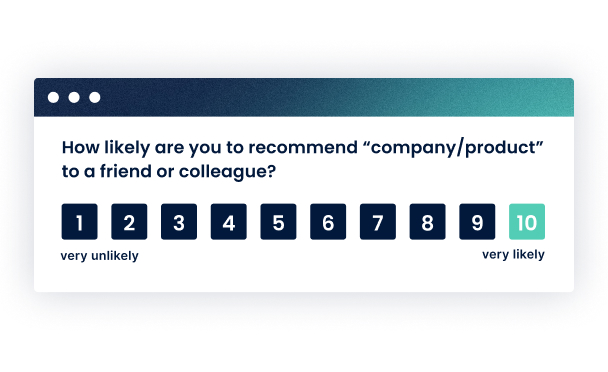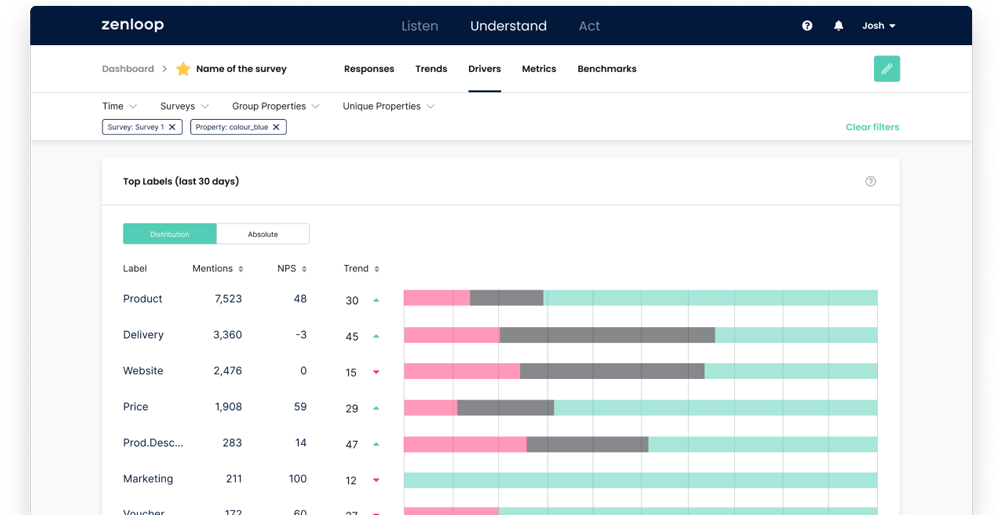Churn Analysis
Determining Churn Rates and Analyzing Churn Behavior
The aim of churn analysis as a part of churn management is to identify customers who are at risk of churning as early as possible, and to dissuade them from their intention to quit.
Nearly everyone has been in this situation at some point: You sit down for dinner in a restaurant. Unfortunately the food didn’t taste that good; it certainly didn’t live up to your expectations. You rapidly and secretly decide that you will probably not visit this place again. When the waiter finally clears away the plates and asks whether the food was tasty, the answer is a friendly: “Yes, the pizza was delicious.” The waiter goes back to the kitchen with a good feeling and passes your feedback to the chefs. After all, you can rely on the visitor’s feedback, right?
Many entrepreneurs and employees feel the same way as this waiter. They often have a good feeling and assume that their customers are completely satisfied. Even if they haven’t received any real feedback at all. But even if the customer gives feedback on their experience with a product or service, it is important to listen carefully and pay attention to the subtleties. Doesn’t a satisfied customer speak of a “very tasty pizza” in praising tones? It is important for companies to precisely identify critics and supporters of a product in order to prevent customer churn.
If the topic is neglected in planning, marketing and management, this has negative effects on the company: For example, the decline in sales and profits or bad investments, such as excessive funding of new customer acquisition.
Churn Analysis: The Basics
Those who are attentive to their customers can usually recognize signs of a lack of customer loyalty and increasing customer churn early on. However, the first signs of customer fluctuation can be lost in the daily hustle and bustle. Therefore, entrepreneurs should regularly ask themselves the following questions:
- Has the number of buyers decreased significantly compared to previous periods?
- Has the customer distanced themselves in the last few months?
- Did the customer pay the last invoice with a noticeable delay?
Could you answer “yes” to one or more questions? Then this is a sign of customer churn. But don’t just bury your head in the sand and give up—lost customers can be won back within the framework of targeted recovery measures.
By now at the latest, you should turn to churn analysis. Because before these measures are implemented, the churn behavior of the customers should be carefully examined and the reasons for the churn determined. Understanding the source of customer dissatisfaction is a prerequisite for taking the right action.
And that is exactly what companies should do, because a lost regular customer cannot simply be replaced by a new one. In addition, acquiring new customers also costs a lot more than supporting customer loyalty, since marketing has to be in full swing when acquiring new customers in order to attract their attention. Therefore, one should bind the customers to the company for as long as possible.
And the following also applies: An ounce of prevention is better than a pound of cure. That’s why companies should deal with customer churn right from the start. As part of a so-called churn analysis, it is possible to effectively examine the topic, understand your own customers and develop measures to keep the churn rate as low as possible.
Definition: What does “churn” mean?
To understand the term, it is worth taking a look at the naming. Churn is an artificial word, or more precisely, a combination of two words: Change and Turn. “Churn” means that the customer wants to change providers or service providers (change) and plans to do so (turn). The term can be understood as “customer change” or “customer migration”.
What is the Churn Rate?
This is the proportion of customers who have stopped buying from the company in relation to the average number of customers or the total customer base within a certain period of time. The churn rate is particularly well known in the customer subscription business, for example in the electricity or telecommunications industry, but also with streaming services such as Netflix or Spotify.
What Information Does the Churn Rate Deliver?
The churn rate helps to define or map the churn rate of a company. It is an indicator of customer dissatisfaction, better competitors or your own weaknesses within the customer journey. The lower the churn rate, the happier your customers are. Of course, this also contributes to the company’s success, because loyal customers generate more sales and higher profits.
How Can the Churn Rate be Minimized?
Companies that want to minimize their churn rate should do one thing above all: listen. If you have an open ear for your customers, you can recognize their dissatisfaction at an early stage and prevent them from leaving. It is important to find out about your own strengths and weaknesses. If you show customers that you are dealing with your deficits and working on them, this has a positive effect on customer satisfaction. The so-called churn analysis is particularly helpful, as it analyzes the process of customer churn in detail. More information on churn prevention can be found in the article on churn management.
Carrying Out a Churn Analysis in 5 Steps
The churn analysis uses internal data to determine the likelihood of termination by customers and, in the course of this, analyzes the factors that led to a termination. The aim is also to develop a kind of warning system that recognizes possible cancellations at an early stage and initiates customer loyalty measures. In the best-case scenario, customer recovery measures can influence the customer’s opinion and prevent churn. In conducting an effective churn analysis, there are five steps businesses should take to reduce the churn rate.
1. The Whys and Wherefores: Recognize Churn Types
Customers have different reasons for canceling a contract It is therefore advisable that companies look into the various causes in detail.
- Active Emigration: Here the customers have made a conscious decision and carried it through to completion. The reasons for this can be very different: internal changes in the company or dissatisfaction with the product.
- Churn of Satisfied Customers: Here, too, there can be various causes for migration. Certain triggers such as an event, a campaign, or a recommendation are usually the reason for a churn.
- Passive Emigration: For example, customers who have not bothered to update their credit card details, have not renewed their contract, or have not contacted the company again after a test period, leave the company passively.
There are a wide variety of reasons for a customer to churn, including:
- Poor customer service
- ineffective customer marketing / ineffective customer approach
- patchy communication
- Neglect of customer loyalty
- rising prices
- changing contact persons
2. What Types of Customers Are We Losing?
A detailed analysis of the customer types is particularly helpful in order to identify which target groups the service or product offered to, does not really fit. In addition, it can be determined which groups of people have a low or particularly high churn rate.
3. Which Subscription Is the Most Lucrative?
For companies that offer a subscription, it is particularly interesting to know which subscription is more lucrative. Are more customers canceling with the basic subscription or with the premium subscription? Different service packages or a tiered pricing system can have an impact on customer churn. If it becomes apparent that the churn rate is particularly high for a certain offer, entrepreneurs should find out the cause. Here it is worth asking customers to get feedback. Perhaps the functions offered are not perceived as an advantage? Together with marketing, a solution can be developed to satisfy customers and clearly highlight one’s own strengths.
4. Perform cohort analysis
Now is the time for a customer lifecycle analysis. In which month was an above-average churn rate found? Why do customers cancel during this period of time? Which touchpoints can be associated with churn?
5. How Is the Performance of the Sales Channels
In the course of the churn analysis, all sales channels should be included, as these channels are well suited for checking customer acquisition. Comprehensive optimization can improve customer loyalty and even prevent customer churn.
For even more meaningful facts, a customer survey is worthwhile to supplement the churn analysis even further. In this way, meaningful data on customer satisfaction can be obtained and thus those customers who tend to churn can be identified.
Data Generation with the Net Promoter Score®
The measurement of the Net Promoter Score, or NPS® for short, makes it possible to determine customer satisfaction. This customer survey methodology is particularly effective in capturing the mood of customers and determining how satisfied they are with certain products or services, but also with the company in general. The measurement of the Net Promoter Score is also particularly customer-friendly and often generates a high level of participation, as it is based on just one question:
How likely are you to recommend the product or service to friends or colleagues?

Customers can now answer this question on a scale from zero to ten and thus express their satisfaction. Then the customers are divided into different groups based on their answers.
- Detractors: These customers answer the question with a number from zero to six and can therefore be identified as critics because they would rather not recommend the product to others.
- Indifferents: If the consumers rate the question with a seven or an eight, they have a neutral opinion on the company and are neither negative nor particularly positive.
- Promoters: Enthusiastic customers like to recommend a product or service to others and are therefore to be defined as so-called promoters. They answer the question with a number from nine to ten and are happy to recommend the product to others.
This enables companies to understand directly how customers are doing. In addition, the direct survey gives them an insight into how they can improve customer behavior and customer loyalty. The data obtained are a starting point for engaging in a more intensive discussion with the customer. If a customer gives a negative rating (detractors), this is a reason to approach them, talk to them about their problems, and, in the best case, find a solution. The goal is to turn critics into promoters and thus satisfy as many customers as possible. The happier customers are, the less likely they are to churn.

How to Stop Customer Churn
Companies have to develop a feeling for their customers and their satisfaction and emotional state, because this is the only way they can develop customer retention measures. Thanks to the data obtained as part of a detailed churn analysis, it is possible to predict churn and thus take action against it in good time. Company employees can identify churn at key points in the customer journey and optimize it with A / B testing:
- new communication / new messages
- selective discounts
- Elimination of steps within the customer journey
- more support for risk accounts
In addition, there are also some measures that every company can implement to keep customer fluctuation as low as possible. The churn analysis already explained is the first important step that companies should not neglect. If the reasons for the churn can be analyzed, it is important to address the customers directly. Entrepreneurs should always give customers a good reason to buy the product or use the service. The actual benefit of the product should be shown to the customer on a regular basis so that the difference or advantage to the competition becomes clear. So it is important to put your own competitive advantages in the spotlight. Furthermore, communication should always be maintained. This can be achieved with well-thought-out marketing and communication via social media (Facebook, Instagram, Twitter …) or clever email marketing.
In the course of these measures, it is important to identify particularly valuable customers and pay close attention to them. Why? These are customers that you definitely want to keep because they are particularly loyal and lucrative. You should treat this customer base with special care and be even more sensitive in the event of any dissatisfaction or comments. In general, it is helpful to divide the clientele into different segments and to determine the respective willingness to emigrate.
Nothing comes of nothing. It is important to regularly offer customers incentives in the form of discounts or special offers. However, it is essential to adapt the offers to the customer segment. Because even the best methods of customer loyalty are useless if they address the wrong target group.
What Does the Churn Analysis Do?
Churn analysis helps entrepreneurs minimize customer churn. A company should not focus exclusively on winning new customers, but should also develop measures to retain existing customers over the long term and to bind them to the company. Customers often disappear silently and without any feedback or a direct indication of why they suddenly decided against the product or service. According to mixpanel.com, it is 97 percent of the users.
Customer churn is a headache for many companies because it is mostly a gradual process that only particularly attentive entrepreneurs notice. Companies that fail to recognize the warning signs of their customers risk high losses and a high churn rate in the worst case. A detailed churn analysis is therefore essential for the success of a company.
Summary: Churn Analysis at a Glance
Effective churn analysis is not magic. The more attentively companies listen to their customers and understand their needs, the lower the churn rate can be. It’s important to understand exactly what types of customers are churning and why they’re doing it. In this way, the risk of customer churn can be minimized in the future. In the course of a churn analysis, you should only act on the basis of solid facts and generate meaningful data, for example using the Net Promoter Score. The better companies are at understanding customer churn and its causes, the better they can support their customers in the future to meet their needs. Because a satisfied customer means that more profits can be made and the company can continue to grow.
Perform a Churn Analysis with zenloop






